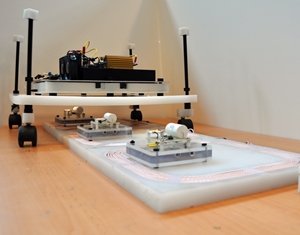Engineers at North Carolina State University in Raleigh developed a new, more dynamic, approach for wirelessly charging moving electric vehicles and built a small-scale prototype to prove the concept. The team led by electrical engineering professor Srdjan Lukic published its findings online in a recent issue of the journal IEEE Transactions on Power Electronics (paid subscription required).
The technique created by Lukic and colleagues improves the efficiency of transferring power from a stationary source — the charging station — and a vehicle in motion. A type of earlier charging system for moving vehicles requires large transmitter coils that emit a low-level electromagnetic field to provide a sufficient quantity of power for the vehicle. But the field created by the large coil is imprecise, with power transferring to the vehicle frame as well as the motor. That large blanketing field is not only inefficient, but also raises safety concerns.
Another earlier approach tried to address these concerns with a collection of smaller transmitter coils. The large number of coils required, however, adds cost and complexity to the solution, and also calls for more precise targeting and detection technology to make it possible to transfer the power needed to charge the vehicle.
The solution devised by Lukic and colleagues in NC State’s Advanced Transportation Energy Center tries to take the best of both approaches. The system has transmitter and receiver coils of about equal size, which helps make the transfer of power more efficient. As with earlier technologies, the power transmitter coil is stationary, while the receiving coil is installed in the vehicle.
The NC State researchers, however, built a capability into the coils to couple electronically with each other when the receiver comes into range of the transmitter. When within range of the receiver, the transmitter coil is designed to increase its power output by 400 percent. The transmitter coil then returns to it original output when the vehicle and its receiving coil leave the transmitter’s range.
Lukic and colleagues built a small-scale prototype, which while functional, only transfers a small quantity of power — 0.5 kilowatts. The team is working on a more powerful 50 kilowatt system, which they say would also be more practical.
Read more:
- ARPA-E to Fund Vehicle Metals, Bio Gas Conversion Research
- 120-Car Fleet Testing Intelligent Vehicle Network
- Nissan, College Establish U.K. Electric Vehicle R&D Center
- Energy Dept to Fund R&D on Vehicle Charging Stations
* * *


 RSS - Posts
RSS - Posts
You must be logged in to post a comment.